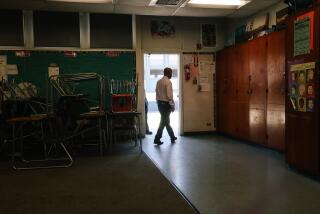Prop. Y Offers Best Method to Fill Need for Classrooms
- Share via
About 35,000 to 45,000 more students are expected in the San Diego Unified School District in the next 12 years, and the district already has begun resourceful planning for them.
Efficiency moves alone should absorb about half of those students. The district estimates that multitrack, year-round calendars for elementary schools, which increase a school’s capacity by 33%, will accommodate up to 12,500 added pupils. Staggered schedules, morning and afternoon kindergarten sessions and under-used schools will absorb about 7,000 students. Portable classrooms will handle another 5,500.
But efficiency is not enough. Between now and the year 2000, schools will have to be built and old ones will have to be expanded if San Diego’s children are to receive a decent education.
On June 7, for the first time in almost 14 years, San Diegans will be asked to approve a property tax increase to build eight schools and to expand or rebuild 18 others.
The tax measure, Proposition Y, was approved once already, in 1974, but was never fully used.
Now it is needed. Even if limits on residential growth are approved in November, demand for schools is outstripping the supply of classrooms.
Reopening closed schools is not a viable option in most cases, the district says, because the schools are not in the growth areas and because busing students--unpopular with parents--would cost more than new schools in the long run.
Developers’ fees, a misnomer because they are passed on to the home buyer, aren’t the solution they might appear, either. They will supplement the tax measure but won’t cover the whole tab. They can only be used to accommodate growth that comes from new housing and until recently were only charged in new areas of the city.
But much of the growth has been in older areas. For example, two elementary schools in Paradise Hills were crowded when they opened in September, 1986. Also, the fees don’t take care of all the growth that comes from increased birth rates.
Reliance on developers’ fees has other liabilities. Schools often are needed before enough fees have been collected to build them. Also, the district worries that the state may curtail them.
A second, and more fundamental, reason to vote for Proposition Y is that schools are the responsibility of all the district’s residents, not only parents and newcomers.
San Diego voters will also face an $800-million state school construction measure on the June 7 ballot. But that will not provide funds for San Diego Unified schools and won’t affect property taxes. The district opted out of the state program because it feared that it could not compete with the $10 billion in demands from other California districts and because San Diego would lose control of its developers’ fees.
Proposition Y thus becomes the best avenue to support the educational needs of San Diego children. If approved, the $143.5-million tax increase would not go into effect until 1992. Property taxes would increase until 1994 and then decline until 2002, when the bond measure expires. In its highest year, it would cost the owner of a $100,000 home about $55 above 1988 rates.
Considering what is at stake, it seems a small price to pay. We urge a yes vote on Proposition Y.
More to Read
Sign up for Essential California
The most important California stories and recommendations in your inbox every morning.
You may occasionally receive promotional content from the Los Angeles Times.










